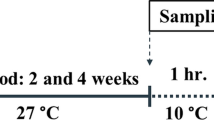Summary
Heat death and resistance adaptation of freshwater crayfish are thought to be properties of its muscle membranes. The inactivation at high temperatures of a membrane-bound enzyme, the Ca++-stimulated ATPase of crayfish abdominal muscle sarcoplasmic reticulum, and the effect of thermal acclimation of crayfish upon the inactivation kinetics have been investigated. In the absence of KCl, the Ca++-stimulated ATPase is irreversibly inactivated with pseudo-first order kinetics at temperatures that cause heat death in the whole animal. 0.1–10.0 mM KCl resulted in slower inactivation, while 100 mM KCl activated the enzyme to 120–180% of its original activity. Enzyme activation by KCl and heat involved a shift in the enzyme concentration/activity curve. Thermal acclimation of crayfish had no significant effect upon the kinetics or Arrhenius activation energy for enzyme inactivation (100.6±10.5 and 92.3±14.6 kcal/mole for preparations from 4°C and 25°C acclimated crayfish).
Ca++-stimulated ATPase isolated from heat dead crayfish exhibited normal in vitro activity due presumably to the high intracellular K+ concentration. Nevertheless, the close correspondence between heat death temperatures and inactivation temperatures for several membrane-bound enzymes of muscle is thought to reflect some perturbation of muscle structure that occurs during heat death.
Similar content being viewed by others
Abbreviations
- ATP:
-
Ademosine 5′-Triphosphate
- EGTA:
-
Ethyleneglycol-bis [β-amino-ethyl ether]
- N:
-
N′-tetraacetic acid
- Hepes:
-
N-2-Hydroxyethylpiperazine-N′-2-ethanesulphonic acid
- FSR:
-
Fragmented sarcoplasmic reticulum
- Tris:
-
Tris (hydroxymethyl)aminomethane
References
Atkinson, A., Gatenby, A.D., Lowe, A.G.: The determination of inorganic orthophosphate in biological systems. Biochim. biophys. Acta (Amst.)320, 195–204 (1973)
Becker, J.H., Willis, J.S.: Absence of cold resistance in sarcoplasmic Ca++ ATPase in a hibernating animal. Comp. Biochem. Physiol.52 B, 533–535 (1975)
Bowler, K.: A study of the factors involved in acclimatization to temperature and death at high temperatures inAstacus pallipes. I. Experiments on intact animals. J. cell. comp. Physiol.62, 119–132 (1963)
Bowler, K., Duncan, C.J.: Evidence implicating a membrane ATPase in the control of passive permeability of excitable cells. J. cell. Physiol.70, 121–125 (1967)
Bowler, K., Duncan, C.J., Gladwell, R.T., Davison, T.F.: Cellular heat injury. Comp. Biochem. Physiol.45 A, 441–450 (1973)
Brandt, J.F.: Heat effects on proteins and enzymes. In: Thermobiology (ed. A.H. Rose), pp. 25–72. London: Academic Press 1967
Cossins, A.R.: Changes in muscle lipid composition and resistance adaptation to temperature in the freshwater crayfish,Austropotamobius pallipes. LipidsII, 307–316 (1976)
Dixon, M., Webb, E.C.: The enzymes, 2nd Ed. London: Longmans 1964
Gladwell, R.T.: Heat death in the crayfishAustropotamobius pallipes: Thermal inactivation of muscle membrane-bound ATPases in warm and cold adapted animals. J. Thermal Biol.1, 95–100 (1976)
Gladwell, R.T., Bowler, K., Duncan, C.J.: Heat death in the crayfishAustropotamobius pallipes: Ion movements and their effects on excitable tissues during heat death. J. Thermal Biol.1, 79–94 (1976)
Grainger, J.N.R.: A study of heat death in nerve-muscle preparations ofRana temporaria L. Proc. roy. Irish Acad.73B, 283–290 (1973)
Hazel, J.R., Prosser, C.L.: Molecular mechanisms of temperature compensation in poikilotherms. Physiol. Rev.54, 620–677 (1974)
Inesi, G., Millman, M., Eletr, S.: Temperature-induced transitions of function and structure in sarcoplasmic reticulum membranes. J. molec. Biol.81, 483–504 (1973)
Laggner, P., Barratt, M.D.: The interaction of a proteolipid from sarcoplasmic reticulum membranes with phospholipids — a spin label study. Archs. Biochem. Biophys.170, 92–101 (1975)
Lowry, O.H., Rosebrough, N.J., Farr, A.L., Randall, R.J.: Protein measurement with the Folin phenol reagent. J. biol. Chem.193, 265–275 (1951)
Madeira, V.M.C., Antunes-Madeira, M.C.: Thermotropic transitions in sarcoplasmic reticulum. Biochem. biophys. Res. Commun.65, 997–1003 (1975)
Martonosi, A., Feretos, R.: Sarcoplasmic reticulum. II. Correlation between adenosine triphosphatase activity and Ca2+ uptake. J. biol. Chem.239, 659–668 (1964)
Meissner, G., Fleischer, S.: The role of phospholipid in Ca++-stimulated ATPase activity of sarcoplasmic reticulum. Biochim. biophys. Acta (Amst.)255, 19–33 (1972)
Read, K.R.H.: Thermostability of proteins in poikilotherms. In: Molecular mechanisms of temperature adaptation (ed. C.L. Prosser), pp. 93–103. Washington, D.C.: Amer. Assoc. Adv. Sci. 1967
Susor, W.A., Rutter, W.J.: Some distinctive properties of pyruvate kinase purified from rat liver. Biochem. biophys. Res. Commun.30, 14–20 (1968)
Tume, R.K., Newbold, R.P., Horgan, D.J.: Changes in the fatty acid composition of sarcoplasmic reticulum lipids and calcium uptake activity. Archs Biochem. Biophys.157, 485–490 (1973)
Ushakov, B.P.: Coupled evolutionary changes in enzyme thermostability. In: Molecular mechanisms of temperature adaptation (ed. C.L. Prosser), pp. 107–130. Washington, D.C.: Amer. Assoc. Adv. Sci. 1967
Author information
Authors and Affiliations
Rights and permissions
About this article
Cite this article
Cossins, A.R., Bowler, K. Resistance adaptation of the freshwater crayfish and thermal inactivation of membrane-bound enzymes. J Comp Physiol B 111, 15–24 (1976). https://doi.org/10.1007/BF00691107
Received:
Issue Date:
DOI: https://doi.org/10.1007/BF00691107




